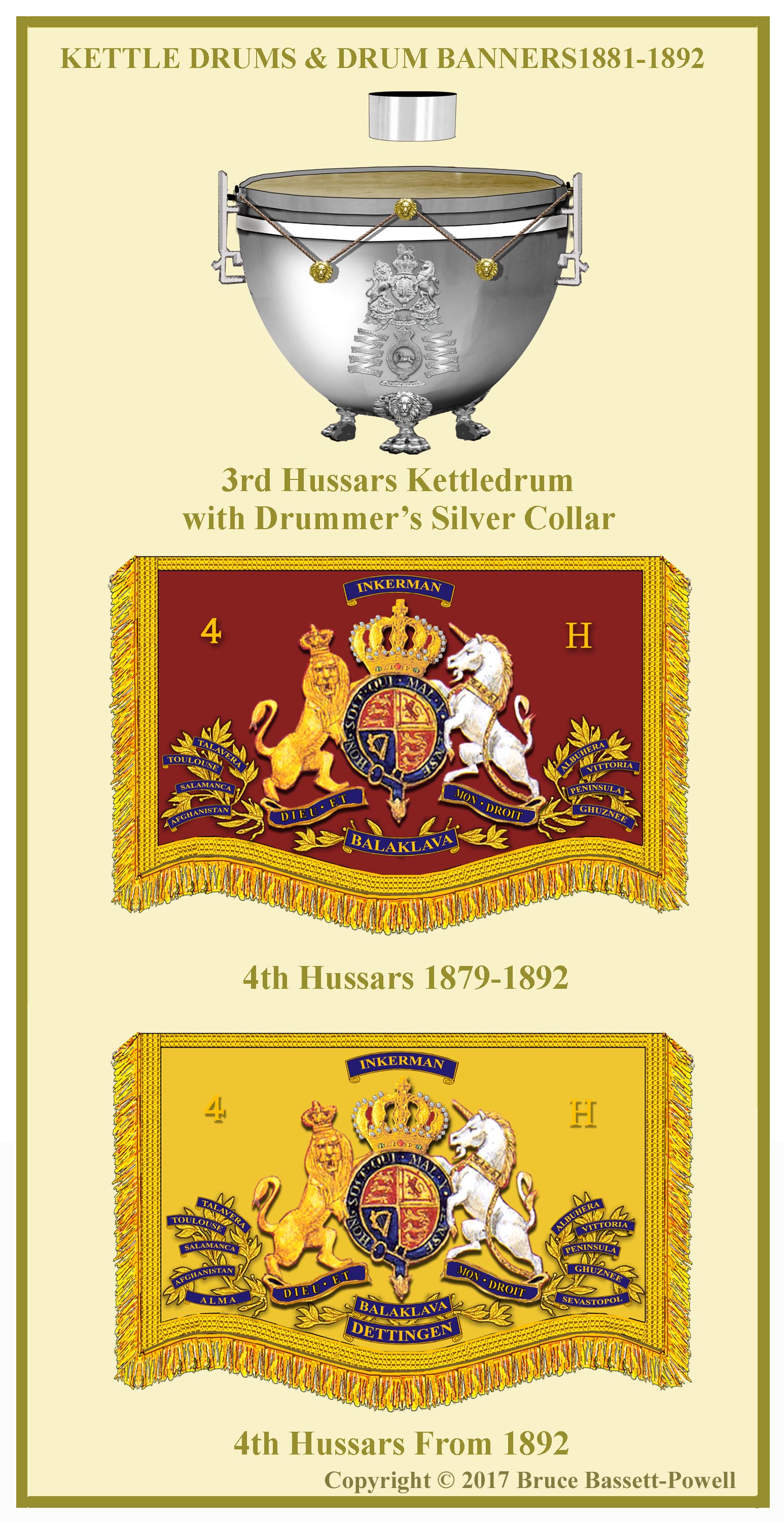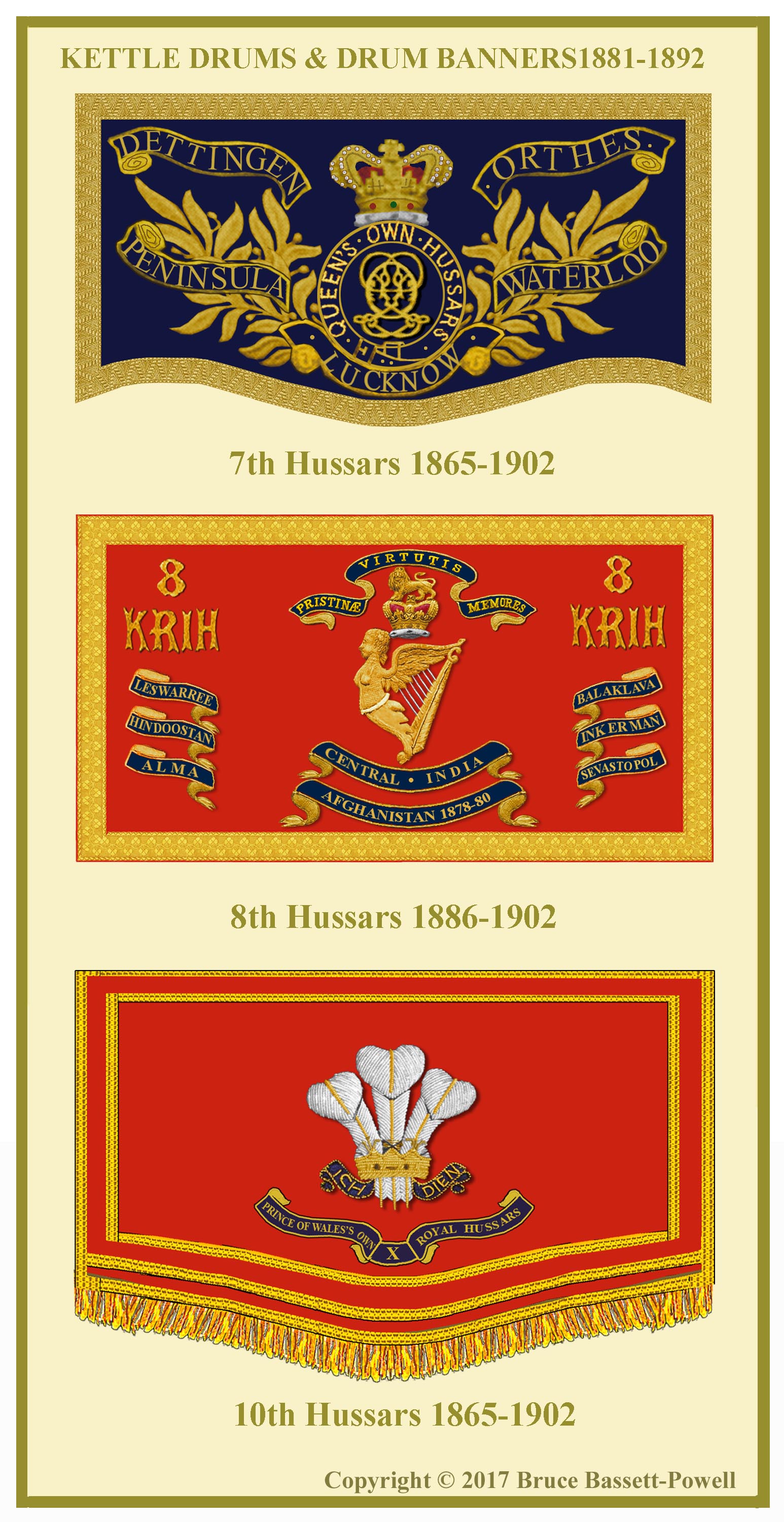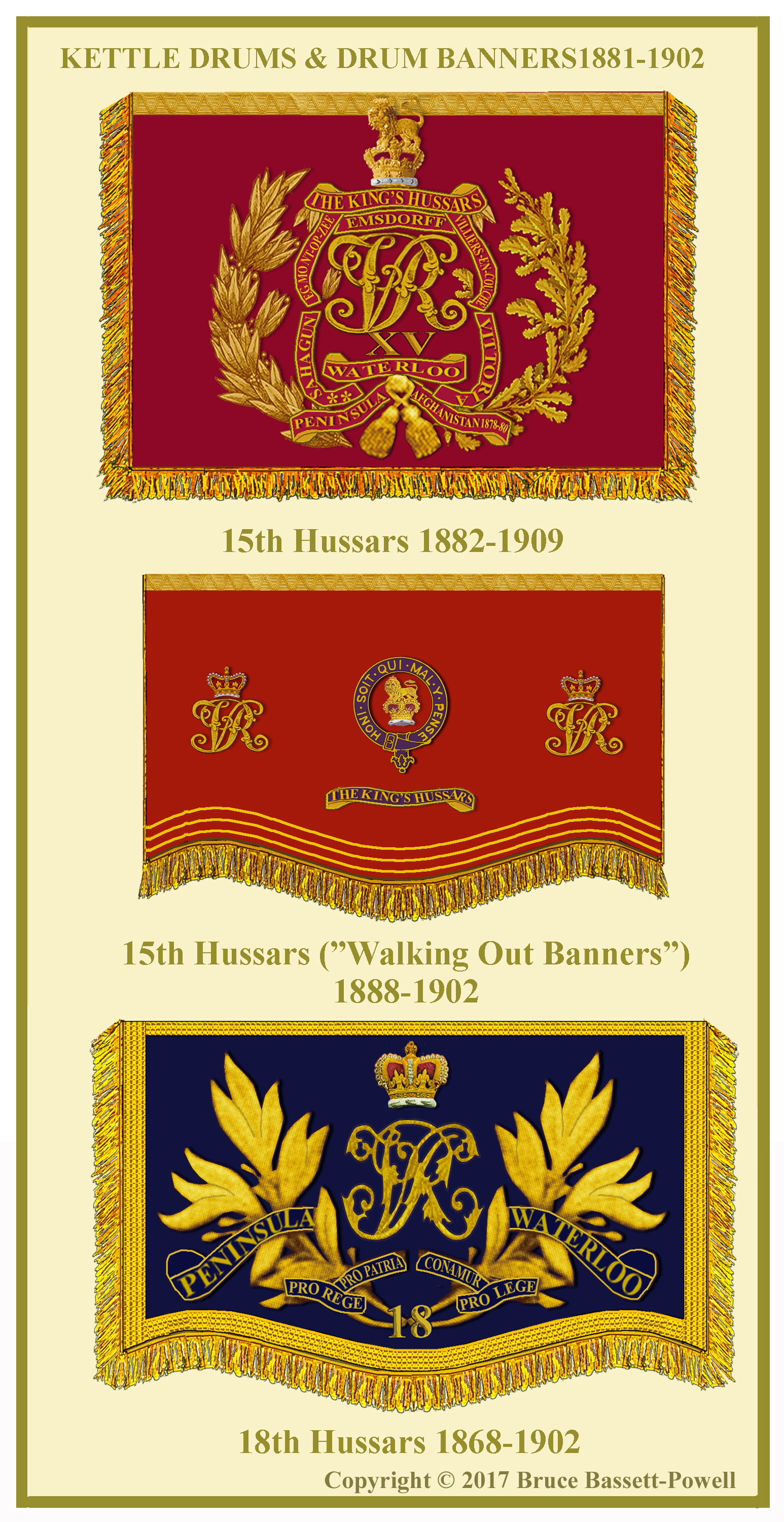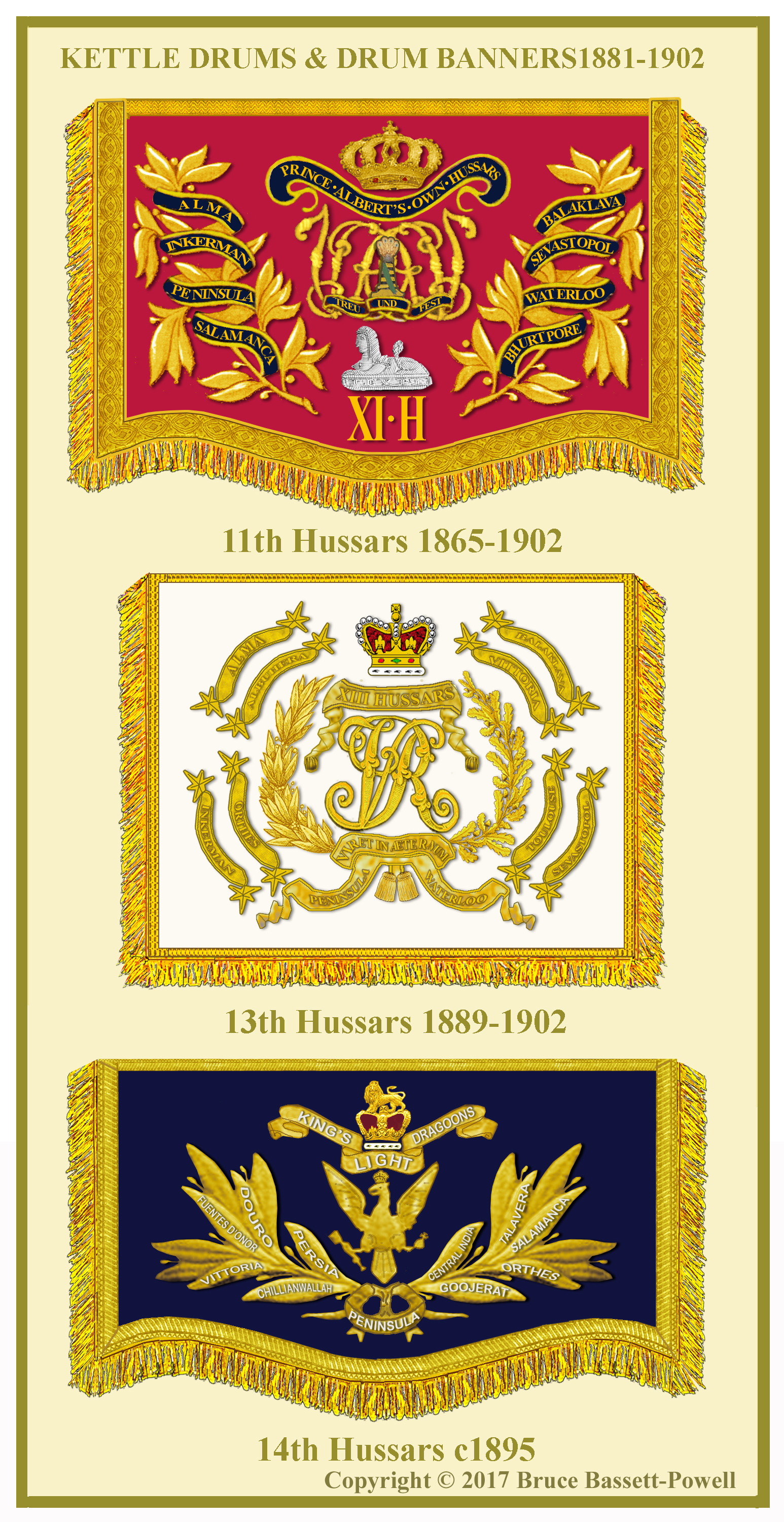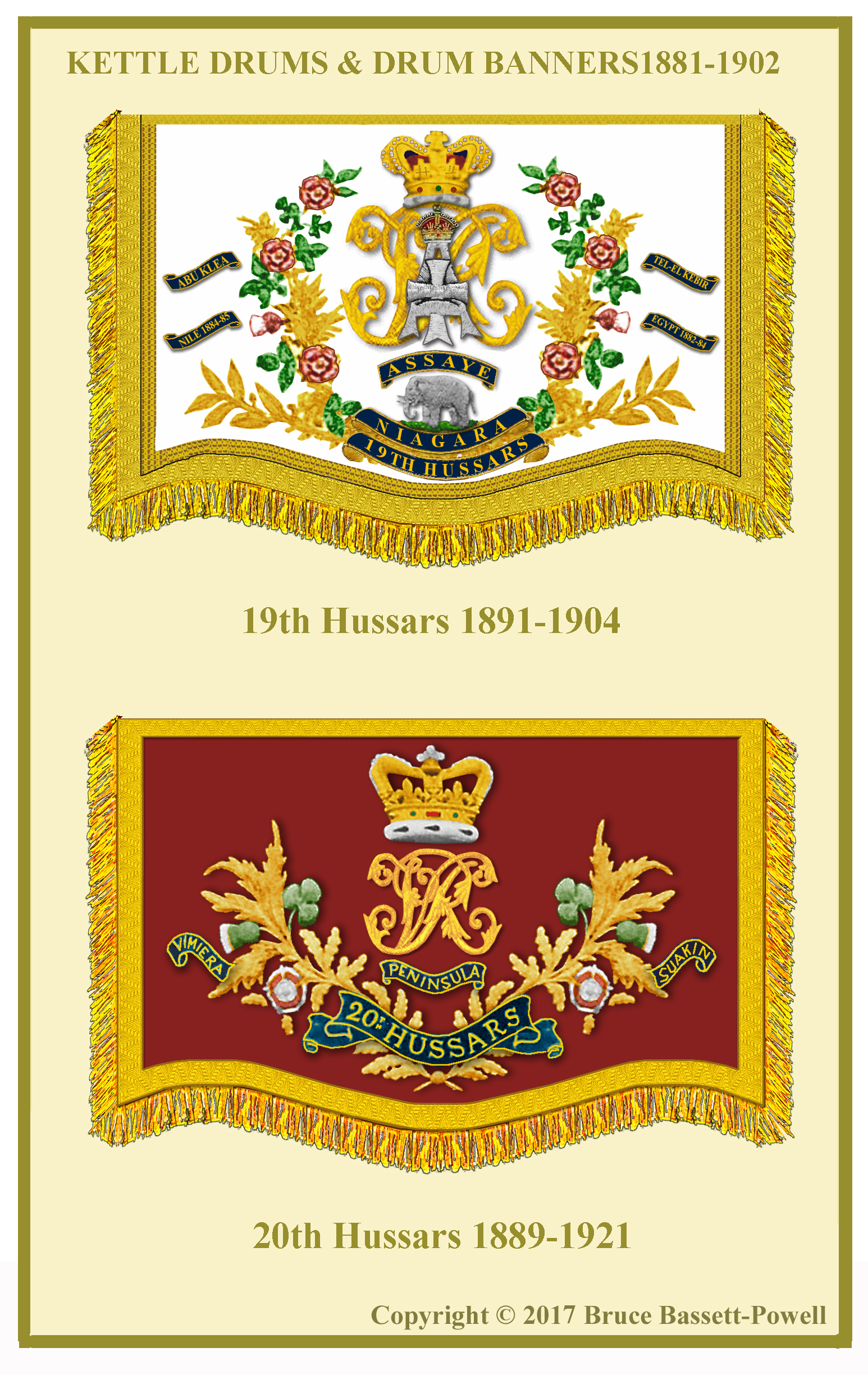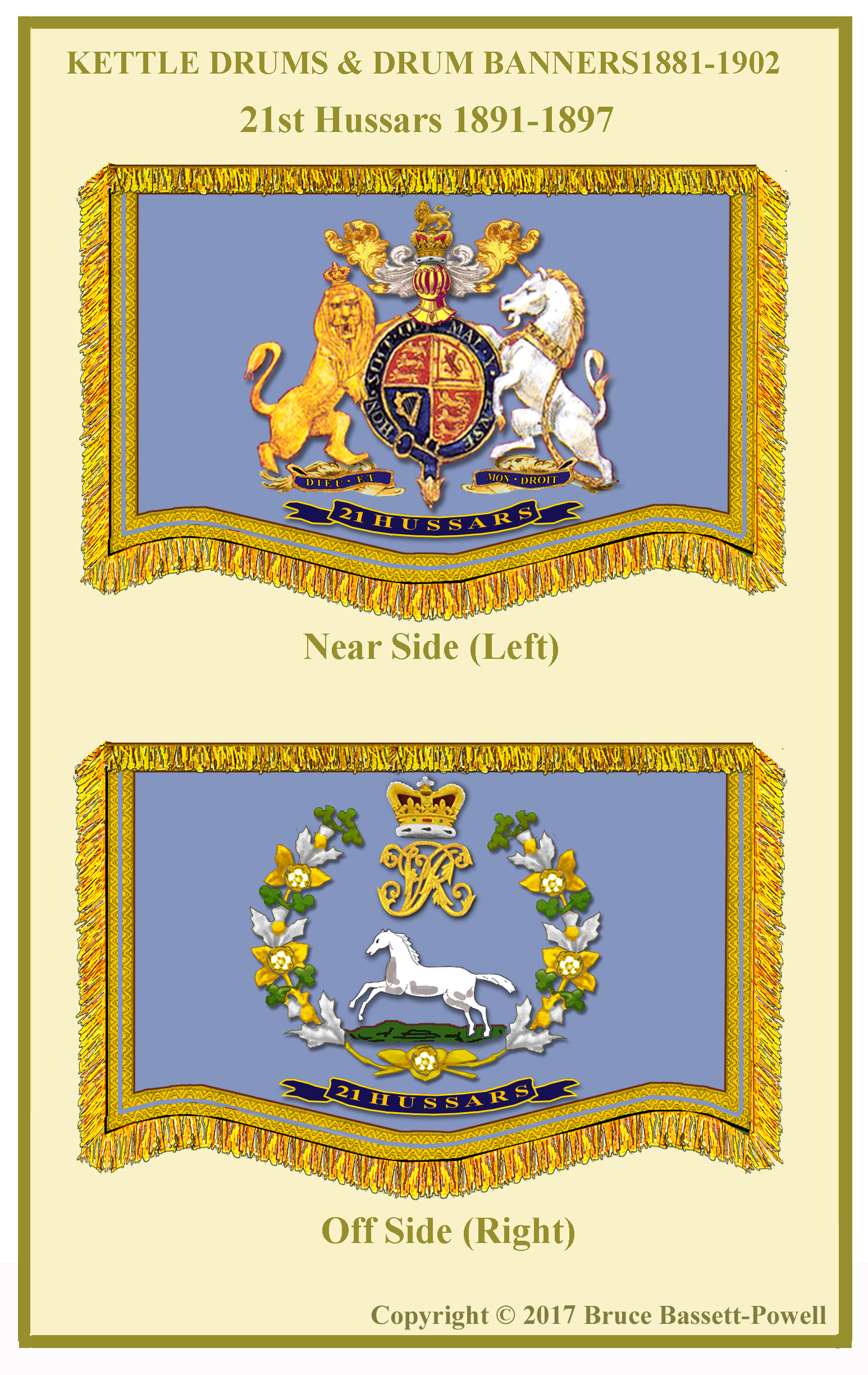UNIFORMS, ARMS & EQUIPMENT - HUSSARS
KETTLE DRUMS & BANNERS
In 1834 the guidons and standards then carried by the light cavalry regiments were abolished and were not restored until the reign of Queen Elizabeth II. The regiments of light dragoons, hussars and lancers henceforth turned to their kettledrum banners for displaying their battle honours and the visual representation of their regimental livery. Drum banners were not accorded the honours that were given to standards and guidons of the heavy cavalry or the colours of Infantry. However, their importance was underlined by the fact that they were taken wherever they went, especially on distant stations throughout the Empire.
By 1881 all the Hussar regiments had their own set of banners and as they were not regulated in any way they were able to express themselves as the commanding officer and regimental committees saw fit. Like their brothers in the dragoons and lancers, these banners were often presented by distinguished persons who had an interest in the regiment.
The 3rd (King’s Own) Hussars
In 1743 at the Battle of Dettingen (during the War of Austrian Succession) a set of silver kettledrums from the French Regiment Gendarmerie. It is often assumed that these drums were carried by the regiment in some perpetuity but this is not true. The drums were carried for a while but apparently were lost in a fire and later replaced. The regiment then used a variety of banners for the next hundred years or so. The last (and very plain) ones were described by Ebsworth in the mid1850s. A brand new set of silver drums were bought by the officers in about 1855 and carried the battle honours and badge of the regiment beneath the Royal Arms engraved on the shell. New battle honours were added later and finally, in 1882 the battle honour Dettingen was placed on the drums (140 years after the drums were captured!)
In addition to the drums, the Regiment has a silver collar, to be worn by the Kettledrummer, awarded by Lady Southampton in 1772 and has been so worn to this day.
Note: This writer has not had an opportunity to view either the drums or the collar at close quarters. The illustration above is based on written descriptions and some photographs.
The 4th (The Queen’s Own) Hussars
The banners carried by this regiment in 1881 were presented some time before 1879. The field was crimson with the Royal Arms in the centre and the battle honours displayed either side on a blue and gold scrolls. A former Colonel of the regiment presented them with a new set in 1891 this time on a yellow field matching the busby bag. The battle honours Alma, Sebastopol and Dettingen were added to these banners.
The 7th (Queen’s Own) Hussars
First presented in about 1865 when the regiment was awarded the battle honour “LUCKNOW”, these banners were carried by this regiment for about seventy years. Some battle honours were added after 1902, but the Victorian Crown and central device remained on them until at least 1932.
The 8th (The King’s Royal Irish) Hussars
This set of banners were carried throughout the period with the addition of the “AFGHANISTAN 1879-80” being made in about 1885. They were not altered again until after the South African War. The banners remained in use for many years with additional honours being added. They remain in the possession of the Queen's Royal Irish Hussars to this day.
The 10th (The Prince of Wales’s Own Royal) Hussars
There are not many photographs of the banners carried before 1902. The simple scarlet ones with the Prince of Wales’s feathers in the centre seem to have been used for most of the period. In about 1904 new banners were presented which were of dark blue cloth with the feathers in the centre of a garter, laurel sprays on each side with battle honours along with lozenges on either side carrying the Welsh Dragon and Rising sun. The King Edward Crown surmounted the Garter.
The 11th (Prince Albert’s Own) Hussars
The drum banners carried by the 11th Hussars from 1881-1902 first appeared in1857 and were apparently not altered until the late 1930s. Although both left and right banners were identical, the sphinxes on each faced forward.
The 13th Hussars
The 13th Light Dragoons had a set of drum banners in the 1850s and photographic evidence of them shows a set on a blue field with a design similar to the later version as Hussars on a white fleld. The set of banners carried before 1900 first appeared when the regiment returned from South Africa in 1885. In 1904 battle honours of South Africa and Ladysmith 1900 were added. At the same time the VR cypher was replaced by that of King Edward VII, but the QV crown remained.
The 14th (King’s) Hussars
The first set of drum banners with the design shown had no battle honours displayed. They were eventually stitched to the laurel leaves in silver lace. After 1902 battle honours for the South African War were added plus others. The Eagle was replaced by the Garter with royal crest within after 1911.
The 15th (The King's) Hussars
These banners appeared in the regiment about 1889 or 1890. The arrangement of the battle honours were quite unique. No new battle honours were added before 1912 when the Victorian Royal crest and cypher were replaced by the Georgian ones. However, the amalgamation with the 19th Hussars saw the banners of both regiments used.
A set of banners on a red field were carried from the 1880s and were used as “Walking out” or “Marching order” banners from the introduction of the new ones. They appear to have gone into storage in bout 1905.
The 18th Hussars
This regiment carried the same set of banners from 1866, soon after they were raised. The battle honours of PENINSULA and WATERLOO were won by the former 18th Hussars who were disbanded in 1821.
The 19th (Princess of Wales's Own) Hussars
As one of the three H.E.I.C Bengal cavalry regiments placed on the British establishment, the 19th inherited battle honours from the previous 19th (then lancers) disbanded in 1821. The first drum banners known, had a dark blue field with the crown and cypher in the centre of a wreath. The elephant in silver was beneath the cypher with the battle honour “ASSAYE” above. (The battle honours of Seringapatam, Mysore and Niagara, were curiously omitted). After their return from the Egyptian campaign in 1887, they were awarded the honours “EGYPT 1882-84”, “TEL-EL-KEBIR”, “NILE 1884-85” and “ABU KLEA”. In 1891 they received new drum banners, this time with a white field but with the elements from the previous banner. The “Dannebrog” cypher of the Princess of Wales was superimposed over the Royal Cypher and the recent battle honours from the Egyptian war were added along with “NIAGARA”. These banners were carried unchanged till about 1904.
The 20th Hussars
For many years, the regiment had a set of banners with the Royal Arms on a deep crimson field with the title of the regiment on a scroll below. In 1889 they were awarded the battle honour “SUAKIN” and chose a new set of banners at the same time. These banners, also on a crimson fteld, included the additional honours of the same numbered regiment disbanded in 1819. These banners appear to have remained the same until the Great War. The banners were depicted c. 1920 with the “GR” Cypher.
The 21st Hussars
As This was the last of the H.E.I.C cavalry regiments to transfer to the Crown. The first banners were described by Ebsworth in the 1870s and had the unique distinction of different near and off side banners. The near side featured the full Royal arms with mantle and crest above. The off side had a leaping horse of Hanover in the centre beneath the crown and cypher surrounded by a wreath in gold and proper colours. These were carried until 1898 when they were converted to Lancers.



